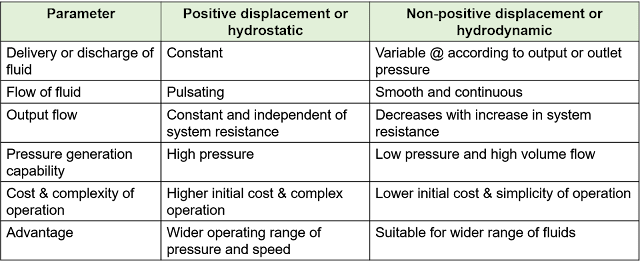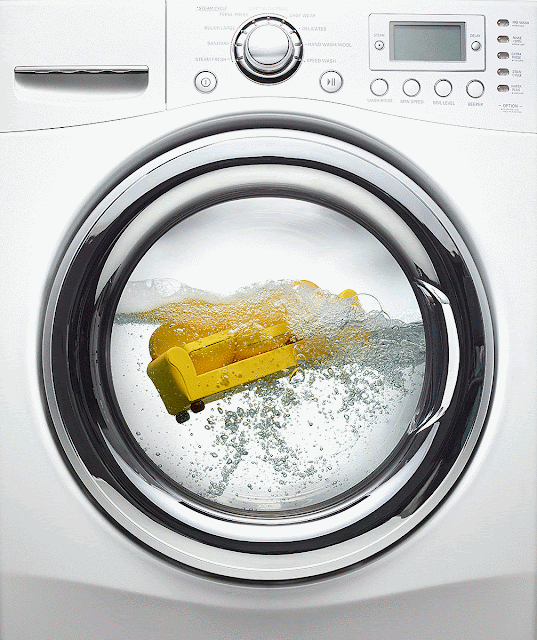Hydraulic Pumps
Hydraulic Pumps
- The electric driving motor combined with the pumping is known as a hydraulic pump (in most pieces of literature, it is referred to as a motor-driven pump also).
- The hydraulic pump takes hydraulic fluid (mostly some oil) from the storage tank and delivers it to the rest of the hydraulic circuit.
- In general, the speed of the pump is constant and the pump delivers an equal volume of oil in each revolution.
- The amount and direction of fluid flow is controlled by some external mechanisms.
- In some cases, the hydraulic pump itself is operated by a servo-controlled motor but it makes the system complex.
- The hydraulic pumps are characterized by its
- flow rate capacity,
- power consumption,
- drive speed,
- the pressure delivered at the outlet and
- the efficiency of the pump.
- The pumps are not 100% efficient.
- One is the volumetric efficiency which is the ratio of the actual volume of fluid delivered to the maximum theoretical volume possible.
- Second is power efficiency which is the ratio of output hydraulic power to the input mechanical/electrical power.
- The typical efficiency of pumps varies from 90-98%.
The hydraulic pumps can be of two types:
- Positive displacement pump or hydrostatic pump
- Non-positive displacement pump or hydrodynamic pump
Positive Displacement Pumps or hydrostatic pumps:
- These pumps deliver a constant volume of fluid in a cycle.
- The discharge quantity per revolution is fixed in these pumps and they produce fluid flow proportional to their displacement and rotor speed.
- These pumps are used in most of the industrial fluid power applications.
- The output fluid flow is constant and is independent of the system pressure (load).
- The important advantage associated with these pumps is that the high-pressure and low-pressure areas (means input and output region) are separated and hence the fluid cannot leak back due to higher pressure at the outlets.
- These features make the positive displacement pump most suited and universally accepted for hydraulic systems.
- The important advantages of positive displacement pumps over non-positive displacement pumps include the capability to generate:
- high pressures,
- high volumetric efficiency,
- high power to weight ratio,
- change in efficiency throughout the pressure range is small and
- wider operating range of pressure and speed.
- The fluid flow rate of these pumps ranges from 0.1 and 15,000 gpm (gallons per minute), the pressure head ranges between 10 and 100,000 psi and specific speed is less than 500.
- It is important to note that the positive displacement pumps do not produce pressure but they only produce fluid flow. The resistance to output fluid flow generates pressure.
- It means that if the discharge port (output) of a positive displacement pump is opened to the atmosphere, then the fluid flow will not generate any output pressure above atmospheric pressure.
- But, if the discharge port is partially blocked, then the pressure will rise due to the increase in fluid flow resistance.
- If the discharge port of the pump is completely blocked, then an infinite resistance will be generated. This will result in the breakage of the weakest component in the circuit.
- Therefore, the safety valves are provided in the hydraulic circuits along with positive displacement pumps. Important positive displacement pumps are reciprocating or piston pumps, gears pumps, vane pumps, and piston pumps.
Non-Positive Displacement Pumps or hydrodynamic pumps:
- These pumps are also known as hydro-dynamic pumps.
- In these pumps, the fluid is pressurized by the rotation of the propeller and the fluid pressure is proportional to the rotor speed.
- These pumps cannot withstand high pressures and generally used for low-pressure and high-volume flow applications.
- The fluid pressure and flow generated due to the inertia effect of the fluid. The fluid motion is generated due to the rotating propeller.
- These pumps provide a smooth and continuous flow but the flow output decreases with an increase in system resistance (load).
- The flow output decreases because some of the fluid slip back at higher resistance. The fluid flow is completely stopped at very large system resistance and thus the volumetric efficiency will become zero.
- Therefore, the flow rate not only depends on the rotational speed but also on the resistance provided by the system.
- The important advantages of non-positive displacement pumps are:
- lower initial cost,
- less operating maintenance because of less moving parts,
- the simplicity of operation,
- higher reliability and
- suitability with a wide range of fluid etc.
- These pumps are primarily used for transporting fluids and find little use in the hydraulic or fluid power industries. Centrifugal pump is a common example of non-positive displacement pumps.
- lower initial cost,
- less operating maintenance because of less moving parts,
- the simplicity of operation,
- higher reliability and
- suitability with a wide range of fluid etc.
Comparison of Positive Displacement (Hydrostatic) pump and Non-positive displacement (Hydrodynamic) pump
- The Centrifugal pump uses rotational kinetic energy to deliver the fluid. The rotational energy typically comes from an engine or electric motor.
- The fluid enters the pump impeller along or near to the rotating axis, accelerates in the propeller, and flung out to the periphery by centrifugal force as shown in figure 1.
- Characteristics of centrifugal pumps:
- The delivery is not constant and varies according to the outlet pressure.
- These pumps are not suitable for high-pressure applications.
- Are generally used for low-pressure and high-volume flow applications.
- The maximum pressure capacity is limited to 20-30 bars and the specific speed ranges from 500 to 10000.
- Most of the centrifugal pumps are not self-priming and the pump casing needs to be filled with liquid before the pump is started.


Figure 1: Centrifugal pump
Reciprocating pumps:
- The reciprocating pump is a positive plunger pump. It is also known as a positive displacement pump or piston pump.
- It is often used where a relatively small quantity is to be handled and the delivery pressure is quite large. The construction of these pumps is similar to the four-stroke engine as shown in figure 2.
- The crank is driven by some external rotating motor. The piston of the pump reciprocates due to crank rotation.
- The piston moves down in one half of crank rotation, the inlet valve opens and fluid enters into the cylinder.
- In the second half of crank rotation the piston moves up, the outlet valve opens and the fluid moves out from the outlet.
- At a time, only one valve is opened and another is closed so there is no fluid leakage.
- Depending on the area of the cylinder the pump delivers a constant volume of fluid in each cycle independent of the pressure at the output port.
Figure 2: Reciprocating pumps (positive displacement)
Comparison of centrifugal and reciprocating pumps







Comments
Post a Comment